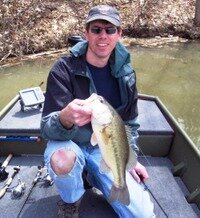Of course they're not yet, but I've been getting a lot of hits to the site for people searching for various information concerning when bass spawn in Indiana. As such, I thought I'd just toss out a few comments on that subject before giving the details of todays trip report.
Bass spawning is a factor of a couple variables coming together. Two of the key ones seem to be photoperiod and water temperature, with general environmental stability a positive factor. If I had to pick a 3 week period in Indiana when I would expect a good wave of spawners locally, the last week in April and the first 2 weeks in May would get my vote. Smaller bodies of water, very shallow waters and waters to the southern third of the state will typically see the first wave of spawners around here. That means that larger, deeper and more northerly waters will typically see a slightly later spawn. Of course nothing is set in stone, and like many things in nature, the spawning population of bass in a lake is probably represented by a bell curve. That means you'll have a small percentage of the population spawning very early, another small group spawning pretty late, but the majority will spawn around a similar time frame.
On our reservoirs it seems like the majority of the bass will spawn in the larger coves and creek arms where you have a slightly more protected environment. Little cuts and pockets within larger coves are especially prone to seeing nesting activity, but any shallow stretch with a little cover, some firm bottom and a little protection can harbor spawners. Bass aren't colonial spawners either like say, bluegill are, so their nests will be spread out down a bank or situated so that spawning pairs can't see other nesters. In extremely silted reservoirs or river backwaters, it's not unusual to find spawning bass using non-traditional nesting sites such as the tops of stumps or the crowns of lily pad roots.
In our northern natural lakes, a good majority of the largemouth will nest in the canals that so commonly get cut out for development. This is always a safe bet to look for bedders. Another portion of the largemouth will nest on the main lake, usually to the inside of weedlines or near remnant cover. Depth will vary based on water clarity, but typically it will be deeper in natural lakes compared to our more murky reservoirs and rivers. The eggs need warmth to hatch faster, and this is usually provided by sunlight.
 Cold fronts and their associated drop in water temps will frequently drive bass off the nests until conditions improve. It partly depends on the severity of the front and the stage of the spawn. Typically you'll want to see water temps that are at least 60 degrees and holding (base temp) as a trigger to get things going. Extended warming around such a base water temperature can really get the nesters going, especially if it falls around a new or full moon. It is the only time of year I really pay any attention to phase of the moon, and here it is just to estimate the potential strength of a possible bed bite. Falling or very fast rising water will also tend to force nesters to abandon a spawning attempt.
Cold fronts and their associated drop in water temps will frequently drive bass off the nests until conditions improve. It partly depends on the severity of the front and the stage of the spawn. Typically you'll want to see water temps that are at least 60 degrees and holding (base temp) as a trigger to get things going. Extended warming around such a base water temperature can really get the nesters going, especially if it falls around a new or full moon. It is the only time of year I really pay any attention to phase of the moon, and here it is just to estimate the potential strength of a possible bed bite. Falling or very fast rising water will also tend to force nesters to abandon a spawning attempt.
As for todays report, I hit Eagle Creek Res. for only the 2nd time in about 4 years. It's always good getting out there. Water conditions were better than expected with temps in the 49-52 range and water clarity about 6". I only got 4 hours in the afternoon, but we were able to put 3 fish in the boat today. These were caught out of coves on the lower end of the lake on jigs. I did get one small one on a crankbait. Lots of fish still sitting in 15-18' of water. Not sure what they were, but the graph would light up every time I moved out over that depth of water.
Speaking of, I think I hit the transducer location for the X-15MT about perfect! I had good readings at all speeds, and the unit was just graphing perfectly at slower speeds. You guys are going to see some great sonar pictures this year if the unit stays dialed in. Pics of the two larger fish are included in this post, above.
One other note. This was the fourth time I've had the the new engine out and running since filling up initially. Covered a decent bit of water today mileage wise. Not being familiar with the gas reading unit, I stopped on the way home to fill up the tank. It ended up taking all of 1.34 gallons and costing me about $4.40 :) and no oil to add either. Doesn't get much cheaper than that.

Excellent information and some very good reading T9!
Capt. Rick
Posted by: Capt. Rick Millette | April 09, 2008 at 11:00 PM
Thanks Rick...BTW, check the sidebar (left) - I've got you linked in now!
Posted by: Big Indiana Bass | April 10, 2008 at 12:57 PM